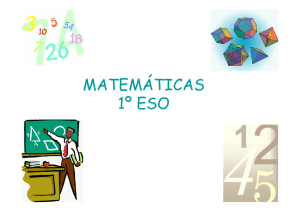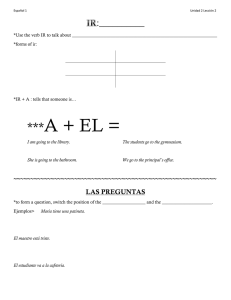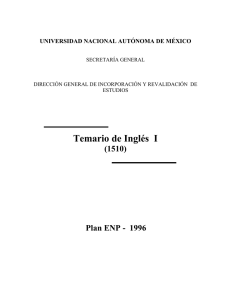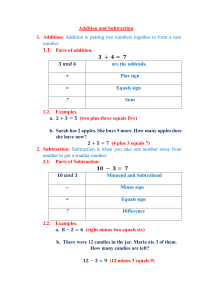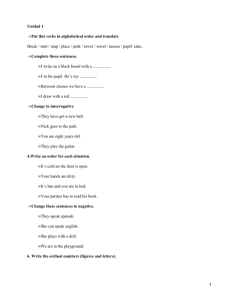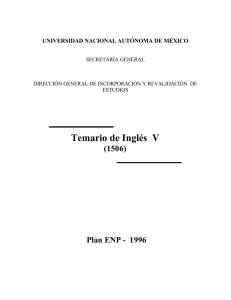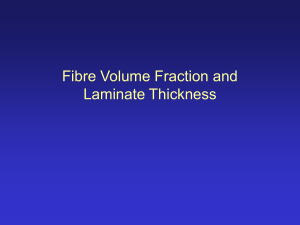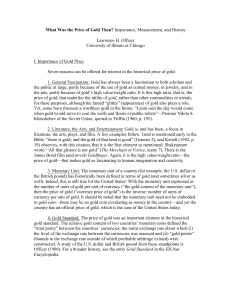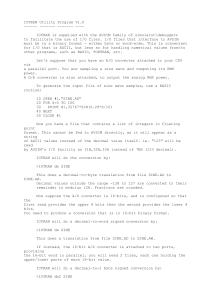MATEMÁTICAS 2º ESO
Anuncio
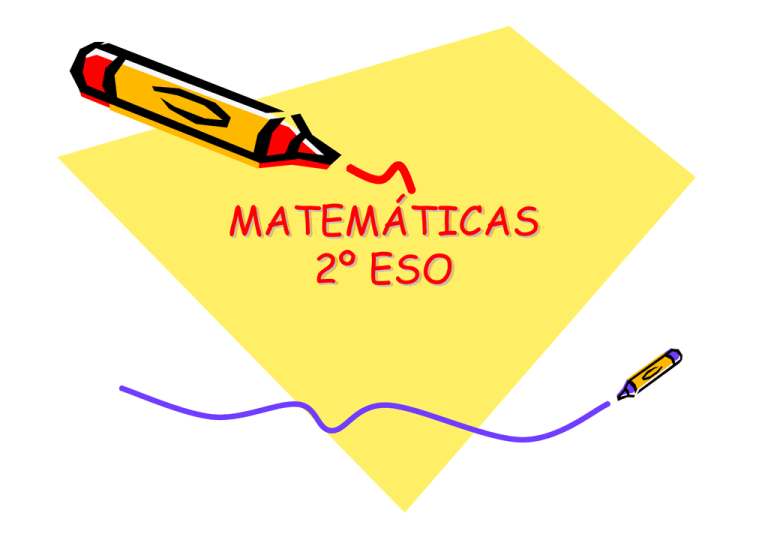
MATEM ÁTICAS MATEMÁTICAS 2 º ESO 2º OPERACIONES BÁSICAS -SUMA: (Addition) the process of adding two or more numbers together to find their total. The addition sign is + · Example: 4+2+6 = 12, four plus two plus six equals twelve (Fist we start by adding four to two, to get the answer six. Then we add six to six, to get the answer twelve). -RESTA: (Substract) to take a number or an amount away from another number of amount. The substract sign is – · Example: 12-6-4 = 2, twelve minus six, minus two, equals two. (To start with, we first substract six from twelve, to get the answer of six; then take four from six, to get the answer of two) -MULTIPLICACIÓN: (Multiplication) the act or process of multiplying. The multiplication sign is x or · · Example: 2 x 2 x 6 = 24, two times two times six, equals twenty-four. (First of all, we times two by two, that equals four; then we multiply four times six to get the answer of twenty-four) -DIVISIÓN: (Division) the process of dividing one number by another. The division sign is : · Example: 12 : 6 = 2, twelve divided by six equals two. (To find your answer you have to think how many times six goes into twelve to get your answer of two) -Now try this: (8+13-6) x 7 : 3 = 35 (First, we start by solving what’s in the brackets: eight plus thirteen minus six equals fifteen. Then, times fifteen by seven, equals hundred an five. After this, we divide hundred and five by three, equals thirty five). -FRACCIÓN: (Fraction) the division of a number · Example: 1/2 , a half; 9/10, nine tenths; 1/16, one sixteenth -Complex fractions: in complex fractions we use the word over, · Example: 19/56, nineteen over fifty-six; 31/144, thirty one over one four four -Whole numbers and fractions: · With and: 2 1/2, two and a half; 5 2/3, five and two thirds · One plus a fraction followed by a plural noun: 1 1/2 pts, one and a half points. -Ordinal numbers: 1st: First 3rd: Third 5th: Fifth 12th: Twelfth 2nd: Second 4th: Fourth 6th: Sixth 21st: Twenty-first… UNIDAD 1: NÚMEROS ENTEROS -Número Natural: Counting number/Natural number -Número Entero: Integer -Criterios de divisibilidad: Divisibility rules -Divisor: Divisor -MÚltiplo: Multiple -Número Primo: Prime Number -Factores Primos: Prime Factors -12 es divisible entre 2: 12 is divisible by 2 -Descomponer en factores primos (factorizar): Factorize/Prime factorization -Mínimo común múltiplo (mcm): Least common multiple (LCM)/Lowest common multiple -Máximo común divisor (MCD): Greatest common divisor (GCD)/Highest common divisor -Valor absoluto: Absolute value/modulus -Igual que (=): equal to -Mayor que (>): greater than -Menor que (<): less than UNIDAD 2: FRACCIONES Y NÚMEROS DECIMALES -Fracción (número racional): Fraction (rational number) -Numerador: Numerator -Denominador: Denominator -Fracción Propia: Proper Fraction -Fracción Impropia: Improper Fraction -Fracción Inversa: Inverse Fraction. -Fracción Equivalente: Equivalent Fraction -Simplificar una fracción: Cancellation of a fraction -Número Decimal: Decimal Number -Decimal Periódico: Recurring Decimal /Repeating Decimal/Periodic Decimal number (Example: 2.3333333…) -Decimal Periódico Puro: Recurring decimal number (Example: 2.333333… -Decimal Periódico Mixto: Mixed-recurring decimal number (Example: 2.5433333…) -Periodo: Recurring number (period) -Fracción Generatriz: Vulgar fraction obtained from a decimal number. UNIDAD 3: POTENCIAS Y RAÍCES -Potencia: Pow -Exponente: Exponent -Base: Base -Elevar un número a “n”: Raise a number to the power “n” -3 al cuadrado: 3 squared (32=3·3=9); 3 squared is 9 -Cuadrados perfectos: Perfect Squared -3 al cubo: 3 cubed (33= 3·3·3=27); 3 cubed is 27 -Encuentra la raíx n-ésima de un número: find the n-th root of a number -Raíz cuadrada: Square Root ( 9); the square root of 9 is 3 The square root of a number is that special value that when multiplied by itself gives the original number. -Raíz cúbica: cube root ( 3 27 ); the cube root of 27 is 3 -Radical: Radical (the special symbol that means “square root”: 9 ) UNIDAD 4: MEDIDA DE ÁNGULOS Y TIEMPO -Ángulo: Angle -Tiempo: Time -Medida: Measurement ANGLE MEASURE: -Grado: Degree (Example: 3º) -Minuto: Minute (Example: 3’) -Segundo: Second (Example: 3’’) TIME MEASURE -Hora: Hour (Example: 3 h.) -Minuto: Minute (Example: 3 min.) -Segundo: Second (Example: 3 s.) -Un minuto son 60 segundos: there are 60 seconds in 1 minute. -Forma compleja: measurement in degree-minute-second (or hour-minute-second) notation -Forma incompleja: measurement in a decimal form (only one unit) -Conversión de forma incompleja a compleja: to change any decimal degrees into degrees, minutes, seconds. (Example: 1.5º is 1º 30’ 0’’) -Conversión de forma compleja a incompleja: to change from degrees, minutes, seconds into degrees. (Example: 1º 30’ 0’’ is 1.5º) UNIDAD 5: RAZÓN Y PROPORCIÓN -Razón: Ratio (same units)/Rate (different units) -Proporción: Proportion (equality of two ratios) -Antecedente: Antecedent -Consecuente: Consequent -Extremos: Extremes of proportion -Medios: Means of proportion -Cuarto proporcional: fourth proportional -Proporcionalidad directa: Direct proportion -Proporcionalidad inversa: Inverse proportion -Proporcionalidad compuesta: Compound proportion -Magnitud: Magnitude -Magnitudes directamente proporcionales: Magnitudes directly proportional -Magnitudes inversamente proporcionales: Magnitudes in inversely proportional -Regla de tres directa: Principle of direct proportion -Regla de tres inversa: Principle of inverse proportion -Tanto por ciento (%): Percentage UNIDAD 6: POLINOMIOS -Expresión algebraica: Algebraic Expression -Lenguaje coloquial: Colloquial Language/Informal Language -Variable: Variable -Monomio: Monomial -Monomio semejante: Like term/Similar term (Example: 2x and 5x are like terms) -Polinomio: Polynomial -Polinomio opuesto: Opposite Polynomial -Grado: Degree -Coeficiente: Coefficient -Coeficiente principal: Leading Coefficient (coefficient of the leading term) -Término: Term -Término independiente: Constant term -Valor numérico de un polinomio: Evaluating a polynomial at a specific value of x. -Igualdades notables: Special Quadratic Polynomials -Cuadrado de una resta: Perfect square Trinomial (difference) -Cuadrado de una suma: Perfect square Trinomial (sum) -Suma por diferencia: Difference of two squares quadratics
